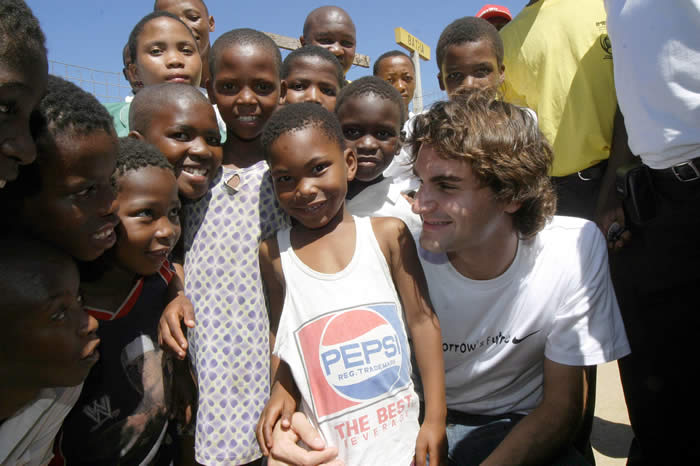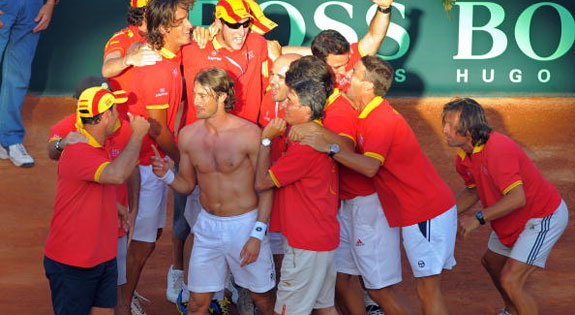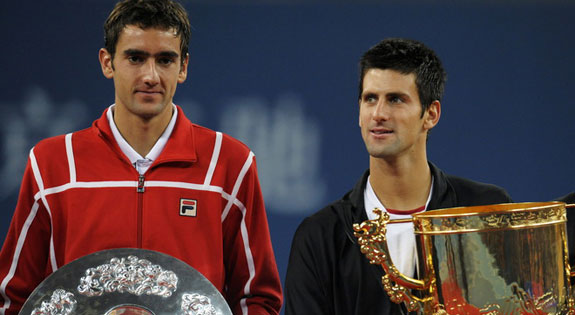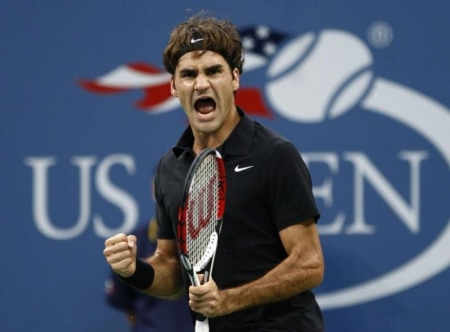Roger Federer is often called the greatest tennis player of all-time, but one other appropriate label is humanitarian. Federer is doing what he can to raise funds to help victims of the earthquake that devastated Haiti on Tuesday.
On Saturday, Federer posted on his Facebook fan page; “Tomorrow at 2pm, with other top players, we are going to have a fun exo at Melbourne Park to help raise monies for relief efforts in Haiti from the devastating Earthquake. Entry fee is a minimum donation of $10. Should be fun and its for a great cause. Hope to see some of you there!
For those who know Federer, it is no surprise that he is taking the initiative to provide humanitarian assistance to this tragedy however he can. In this chapter excerpt from the book THE ROGER FEDERER STORY: QUEST FOR PERFECTION ($24.95, New Chapter Press, www.RogerFedererBook.com), author Rene Stauffer discusses Federer and efforts to support charities and his slipping into the roll as a global ambassador.
The Ambassador
On a Noble Mission
Roger Federer was in Sydney, Australia, when on December 26, 2004, a gigantic earthquake off the island of Sumatra in Indonesia created a tsunami that killed over 200,000 people in the region. Federer was deeply troubled by the tragedy. After flying over the catastrophic area en route to the Qatar Open in Doha only days later, he intensely followed the media coverage of the tsunami on television in his hotel.
“The whole thing really affected him like nothing else before,” said girlfriend Mirka Vavrinec on the phone just days after the tragedy. The couple had finished a vacation in the Maldives only three weeks earlier where they flew out of Colombo, Sri Lanka, one of the most affected areas of the gigantic tidal waves. “We have close acquaintances there but we haven’t been able to reach them for days now,” said Mirka. Roger and Mirka were very connected to the region, having vacationed in the Thai island of Phuket and other areas in the region devastated by the tsunami. A few weeks before the tragedy, Federer won the Thailand Open in Bangkok. “It was a big shock for me,” he wrote on his website. “It’s hard to imagine what the people there are going through.”
In an initial, spontaneous act, Federer transferred 20,000 Swiss francs ($16,000) to a Swiss relief organization. But he felt that he could do more and he wanted to do more. Back in Australia, he committed himself, along with other athletes, to a campaign at Melbourne’s “Nike Town,” where over 100,000 Swiss francs ($80,000) was raised. Nike matched this amount and contributed clothing for victims. On the eve of the Australian Open, Federer declared his willingness to “play any particular match to help the victims.” It wasn’t enough for him just to autograph racquets to be sold at auctions. He himself took the initiative and summoned his fellow players to conduct a unified campaign.
The result was a unique event in professional tennis. Before the tournament in Indian Wells, nine top players played an exhibition event on March 11 to raise money for tsunami victims. Top women players like Kim Clijsters, Elena Dementieva, Amelie Mauresmo and Daniela Hantuchova also participated. Players even collected contributions in cans from fans in the stands—resulting in $18,282.76 alone. The cash collected—as well as money raised from ticket sales for the event—was transferred to tsunami victims via UNICEF. A three-year children’s relief program, the ACE (Assisting Children Everywhere), was also launched at the same event between UNICEF and the ATP. Later in the year before the US Open, Federer was recognized by UNICEF on behalf of the tennis tour for his charitable works. In April of 2006, UNICEF named Federer as a “Goodwill Ambassador” in a ceremony in New York.
What differentiates Federer from many other athletes who are willing to give back to people who are in need is the personal devotion. It’s not enough for him just to send money. He is, as the campaign in Indian Wells demonstrated, also willing to get himself personally involved and invest his precious time to the project.
The Roger Federer Foundation—with headquarters in Bottmingen, Switzerland—was founded on December 24, 2003, shortly after he won his first Grand Slam title and before he was anywhere near financial security. The foundation’s goals were to support needy children and to promote youth sports.

The foundation soon entered into a cooperative partnership with the Imbewu Organization, a South African relief organization with a branch in Switzerland committed to helping disadvantaged children and youth in the New Brighton Township in the South African city of Port Elizabeth. The township is among the poorest and most crowded slums in South Africa, where AIDS, violence and disease account for countless lives. Federer’s foundation makes it possible for 30 children to attend classes in three different schools. The foundation picks up costs for meals, school uniforms and school materials and also finances three full-time social workers.
“I’ve already won so much in my short tennis career. I would like to give something back with my foundation, especially to those that have the least,” Federer said at the time, explaining the purpose of his foundation. He hit upon the idea of South Africa, he said, “because my mother grew up in this country and I’ve always had a close tie to South Africa. South Africa for me is a model state that has overcome hatred and oppression.”
The fact that for Federer, the foundation is a matter of cause and not effect became evident in the way he organized his first visit to the New Brighton Township in the early days of March, 2005. His communications advisor at the time, Thomas Werder, suggested he allow several media representatives to travel with them to events in the township and generate major publicity hits in numerous media outlets. Federer, however, refused. It wasn’t a matter of achieving the greatest possible media coverage under the motto of “do good works and talk about them.” The news of his visit to the township came as a surprise to most of the Swiss media. The small report ran on the visit late in the evening via the Swiss News Agency on March 2, 2005, when most newspapers had very little news space for the event and featured the story as only a news brief.
Accompanying Federer on his township visit was Mirka, his mother and Nicola Arzani of the ATP. “He didn’t want to make a big deal out of it,” Arzani recollected. “I convinced him to at least allow a photographer, a cameraman and a local journalist.” Federer, he said, spent the entire day in New Brighton, played soccer and basketball with students, planted a tree and passed out 2,500 T-shirts with the saying “I’m Tomorrow’s Future” on them. He also visited schools, infirmaries and a girl’s home. Then he ate the traditional Xhosa meal of corn grits with beans with the children who sang and danced for him.
“I wasn’t afraid at all,” he later explained to Mark Mathabane, a South African living in the United States who wrote about the visit in Deuce magazine. “I wanted to see things for myself, to feel what it’s like to live like that. I also wanted to find out how much difference my foundation was making in the lives of the people there.” In November of 2005, Federer’s parents presented the township with a multi-functional sports facility for basketball, netball and soccer.
In 2007, the Roger Federer Foundation was re-launched. New people came on board, like Christophe Schmocker, a very experienced man when it comes to foundations and charities. “The goal is to play in a higher league,” Schmocker said. A new website and new projects were also launched, like Federer’s sponsorship of ten young Swiss athletes from different sports. One of the main goals of the foundation was “to help selected poor countries in the southern hemisphere,” Schmocker explained. For example, the foundation sponsored a school in Ethiopia.
The Wimbledon champion quickly became aware that his position at the top of his sport would accord him the opportunity of becoming a role-model, to become an ambassador and to bring attention to matters that needed attention.
“If you ask me, he is the best tennis ambassador we’ve ever had,” said Arzani. “He’s so easy to work with because he understands perfectly the thing he is responsible for. He’s completely dedicated to whatever it is he’s doing. He does things not just because he has to. He always wants to know exactly why he is doing it, who will profit from it, why a tournament wants to do a particular thing, or why he should be doing a particular thing with the media. He’s very committed to everything that he does.”
“The enthusiasm he has for tennis is incredible,” said Yves Allegro, one of his best friends. “There’s nobody like him. This presents tennis—in fact the entire world—with a unique opportunity.” John McEnroe made almost the same observation in 2005. “Roger cares about tennis. He embraces the responsibility of being ranked No. 1 in the world,” he told Newsday.
When asked by Switzerland’s special UN ambassador for sports, Adolf Ogi, if he was willing to help launch 2005 as the “International Year of Sports and Education” on behalf of the UN, Federer immediately agreed. Together with UN General Secretary Kofi Annan, Federer and Ogi announced this initiative at UN headquarters in New York on November 5, 2004. Almost a year later, Federer submitted an interim report on the project at the Palace of Nations in Geneva. He conducted both appearances with great enthusiasm.
“I am convinced that sports can help overcome disadvantages as well as build bridges between cultures and nations,” Federer posted on his website. “If I can make my modest contribution to this, I certainly will. As ambassador for sport, making a contribution to help others is a very noble mission.” Before Christmas of 2006, he took some time off to visit India in his role as UNICEF ambassador.
The role of ambassador appears to fit Federer well. Mark Miles, the former 16-year CEO of the ATP, couldn’t believe his eyes when Federer and his girlfriend organized a media day in Hong Kong after the US Open in 2004—on their own initiative—to satisfy demands for Federer’s time, as well as to promote the booming tennis movement in Asia.
Federer’s willingness to help also created admiration with the organizers of the Tennis Masters Cup in Shanghai. They reservedly asked him if he would be willing to dedicate the new Qi Zhong Stadium in person as a lead-in to the 2005 Tennis Masters Cup. Federer willingly accepted. When he arrived in Shanghai for the one day visit after his win in Bangkok, he gave interview after interview and, instead of playing just one set of tennis with organizers and officials on the Centre Court at the facility, he played two sets. He also spent a great deal of time with the organizers, government officials, the media and fans. He even paid a visit to the kitchen after dinner to thank the cooks.
During the Tennis Masters Cup in Shanghai, reporters brought up his pre-event visit to christen the stadium and summarized that no other player would have done what Federer did to pre-promote the event, especially playing more tennis than was required. “My doubles partner wanted to play another set and I said, ‘OK, no problem,’” he said. “We even won both sets. It was fun. It was fun to get a glimpse behind the scenes. In general, it’s not every day that you can spend time with government officials, especially from China.” He also observed that “tennis has given me so much that I’m convinced that I should give something in return. It’s not a must for me but it makes me feel much better. I’m proud to support tennis or sports, and I hope the future No. 1 player will do this as well.”
Lynette Federer enjoyed watching her son grow into his role as an ambassador and first noticed the great change within him when he first became the No. 1 player in the world in 2004. “Roger has become a perfectionist. He’s very exact,” she said in 2004. “It was completely different before. He didn’t take things seriously and was always late. He’s taking his role as No. 1 very seriously.” She said that he stands for values like honesty, candidness, friendliness, team spirit, responsibility, loyalty and integrity.
Federer has been a role model for many fans and ambitious young tennis players for a long time. He has become somebody worth looking up to. He has probably signed more autographs and is more accessible than any No. 1 player ever before. “To make a dream come true for some people,” Federer said once when asked why he was so patient when signing autographs. “When I was a ball boy, I also used to run after all the players in the hallways to get autographs. At home, I would then look the autographs as the catch of the day. I know how it is and I haven’t forgotten that.” One of his customs during tournaments is to invite unknown professionals or juniors to practice with him to give them an experience they’ll never forget.
Federer knows that his opinion carries more weight than others and he uses it responsibly. He is not the type of person who spouts insipid clichés or promotes radical changes. He prefers supporting tennis traditions and conventional issues. He is against abolishing line judges in favor of electronic systems. He is against experiments with new scoring systems, as has been partially implemented in doubles events. He also was against the experiments with more round-robin tournaments, that promptly failed in early 2007. He also defended the rights of smaller tournaments to exist. “I think it’s wrong if everything is just measured according to the Grand Slams because then other tournaments would also be basically meaningless,” he said. But of course, he is aware of the fact that in the end, his own career will be primarily evaluated by how many Grand Slam titles he won and how many weeks he ranked No. 1 in the world.
Federer is not only an ambassador for sports, but also for Europe and especially Switzerland. Despite his close ties to South Africa, he consistently demonstrates how much Switzerland means to him. Representing Switzerland in Davis Cup play and the Olympics is very important to him, but unfortunately, his commitment to Davis Cup has sometimes been sacrificed to attend to priorities in his singles career. He described the moment he led the Swiss Olympic delegation as the flag-bearer at the Opening Ceremonies at the 2004 Olympic Games in Athens, Greece as one of the proudest of his life.
But above all, Roger Federer is a highly-talented, hard-working tennis ambassador who loves every facet of his sport. He is one who strives to promote his sport at any possible occasion and who knows that through tennis he can provide joy to a great number of people—and maybe make the world a little better place to live.



